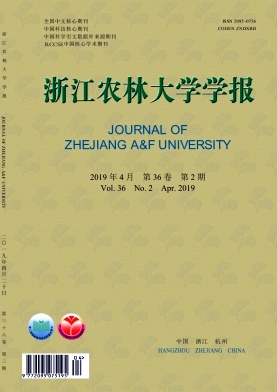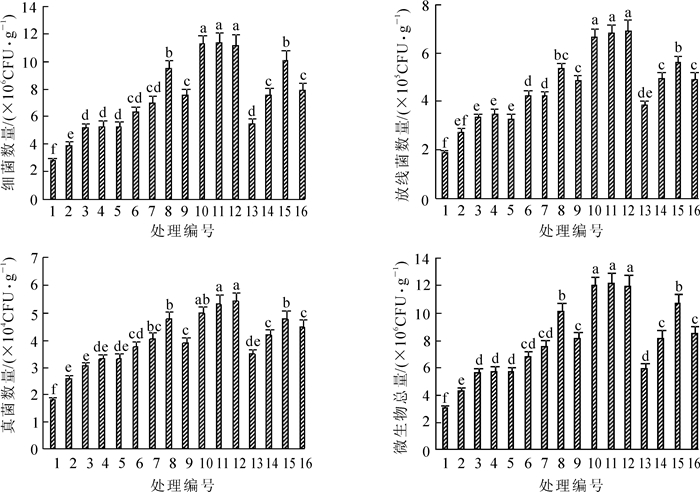-
竹叶花椒Zanthoxylum armatum属芸香科Rutaceae花椒属Zanthoxylum植物,其果实是重要的调味料、香油料和中药材,因其具有适应性广、生长迅速、早实丰产、抗病虫性强和盛产期长,以及耐干旱瘠薄、根系发达和固土保水保肥能力强等优点,在退耕还林工程中,作为经济价值高、生态效益好的经济树种广泛栽植[1]。竹叶花椒以其叶片狭长如同竹叶状而得名,又因其成熟后鲜果碧绿色、干果灰绿色而又被称为“青花椒”[2-3]。目前,竹叶花椒已成为低海拔山丘区新的经济增长点,在国家实施精准扶贫带动山区农民脱贫致富过程中发挥了重要作用。另外,竹叶花椒喜热喜肥,不耐水淹,适宜在排水良好和湿润肥沃的土壤条件下生长[4-5]。因此,进行科学的水肥管理对促进竹叶花椒更好生长和尽早挂果投产具有重要作用[6]。目前,有关土壤水分和施肥对土壤养分含量和微生物特性的研究较多,如韦泽秀等[7]研究发现:适当的水肥处理使土壤有效养分含量和微生物多样性显著提高,土壤生产潜力增加;陈鸿飞等[8]研究发现:合理的水肥调控有利于增加土壤中养分的有效性,提高土壤微生物的功能多样性;王景燕等[9]研究发现:水肥耦合对汉源花椒Z. buugeauum ‘Hanyuan’的地径、苗高和生物量有显著提高作用。有关水肥管理对花椒土壤养分和微生物影响等方面的研究尚未见报道,难以满足当前花椒产业发展需要。本研究以竹叶花椒新品种汉源葡萄青椒Z. armatum ‘Hanyuan Putaoqing’为对象,通过水肥处理盆栽试验明确不同土壤含水量和氮、磷、钾配方施肥量对竹叶花椒生长、土壤有效养分和微生物特性的影响,为竹叶花椒栽培管理过程中,水肥管理提供参考。
HTML
-
供试土壤为四川农业大学成都校区周边农田耕层(0~20 cm)沙壤土。多点采集有代表性的土壤样品共计约1.0 kg,土样自然风干去除杂质过5 mm筛混匀后待用,用于测定土壤理化性质本底值。盆栽前土壤理化性质:pH 7.5,土壤含水量为25.2%的田间持水量,有机质16.6 g·kg-1,全氮1.0 g·kg-1,碱解氮80.3 mg·kg-1,全磷0.48 g·kg-1,有效磷15.4 mg·kg-1,全钾23.9 g·kg-1和速效钾22.5 mg·kg-1。栽植前,取风干土6.3 kg(相当于6.0 kg烘干土),其中2/3先装入聚乙烯塑料盆内(盆口直径22 cm,盆底直径20 cm,高23 cm)中,另外1/3与需添加的肥料充分混匀后再装在上部,盆内土壤厚度约20 cm。
水肥耦合试验采用4因素4水平正交试验设计,共计16个处理(表 1),3次重复,每重复栽植3盆,总计9盆·处理-1,共计144盆。土壤含水量设置为20.0%,40.0%,60.0%和80.0%的田间持水量,氮肥(尿素,氮质量分数为46.4%,施肥量以氮计)施肥量设置为0,75.0,150.0和300.0 kg·hm-2,磷肥(过磷酸钙,五氧化二磷质量分数为12.0%,施肥量以五氧化二磷计)施肥量设置为0,30.0,60.0和120.0 kg·hm-2,钾肥(硫酸钾,氧化钾质量分数为51.0%,施肥量以氧化钾计)施肥量设置为0,75.0,150.0和300.0 kg·hm-2。盆内具体的施肥量按照单位面积进行折算,所有肥料均一次性施入。在2016年4月中旬将苗高约10 cm的竹叶花椒‘汉源葡萄青椒’幼苗移植于各处理盆栽土壤中,试验在温室大棚内完成(本试验中温室大棚只避雨不控制温度和湿度)。整个试验过程中,各处理土壤田间持水量采用每日定时称量补水法进行调控。
处理编号 施肥处理 含水量/% 施肥量/(kg·hm-2) 地径D/cm 苗高H/cm D2H 氮 五氧化二磷 氧化钾 1 W20N0P0K0(ck) 20 0 0 0 0.40 ± 0.02 f 52.2 ± 2.9 f 8.4 ± 0.6 f 2 W20N75P30K75 20 75 30 75 0.52 ± 0.02 e 59.9 ± 2.6 e 16.0 ± 1.3 f 3 W20N150P60K150 20 150 60 150 0.63 ± 0.03 d 69.3 ± 3.4 cd 27.6 ± 2.2 e 4 W20N300P120K300 20 300 120 300 0.65 ± 0.03 cd 71.5 ± 3.2 cd 29.8 ± 3.5 de 5 W40N0P30K150 40 0 30 150 0.63 ± 0.04 d 66.2 ± 3.5 de 26.6 ± 2.4 e 6 W40N75P0K300 40 75 0 300 0.70 ± 0.03 cd 72.8 ± 3.7 cd 35.3 ± 4.1 cde 7 W40N150P120K0 40 150 120 0 0.71 ± 0.04 cd 75.4 ± 4.3 bcd 38.0 ± 5.5 cde 8 W40N300P60K75 40 300 60 75 0.73 ± 0.04 bc 80.8 ± 3.7 ab 43.4 ± 5.5 bc 9 W40N0P60K300 60 0 60 300 0.69 ± 0.03 cd 76.9 ± 4.0 bc 36.9 ± 4.6 cde 10 W60N75P120K150 60 75 120 150 0.77 ± 0.03 ab 88.8 ± 3.5 a 53.0 ± 5.6 ab 11 W60N150P0K75 60 150 0 75 0.81 ± 0.05 a 89.9 ± 3.6 a 58.6 ± 9.1 a 12 W60N300P30K0 60 300 30 0 0.83 ± 0.05 a 92.0 ± 5.0 a 63.1 ± 9.4 a 13 W80N0P120K75 80 0 120 75 0.66 ± 0.04 cd 70.4 ± 3.9 cd 30.5 ± 4.6 de 14 W80N75P60K0 80 75 60 0 0.73 ± 0.03 bc 78.5 ± 4.0 bc 41.4 ± 5.3 bcd 15 W80N150P30K300 80 150 30 300 0.75 ± 0.04 bc 82.7 ± 4.7 ab 46.2 ± 6.5 bc 16 W80N300P0K150 80 300 0 150 0.73 ± 0.04 bc 78.8 ± 4.7 bc 41.5 ± 2.8 bcd 说明:数值后同列不同字母表示处理间差异显著(P < 0.05) Table 1. 4 factors and 4 levels orthogonal test scheme processing, ground diameter (D) and height (H) of seedlings
-
于2016年11月中旬,用游标卡尺和卷尺测定竹叶花椒幼苗地径和苗高。将竹叶花椒苗从盆中移出后采集土壤样品,一份带回实验室风干后用于测定土壤碱解氮、有效磷和速效钾质量分数;另外一份用无菌袋装好,带回实验室用于测定土壤细菌、放线菌和真菌数量。碱解氮采用碱解-扩散法,有效磷采用Olsen法,速效钾采用乙酸铵浸提-火焰光度法[10];微生物数量采用稀释平板法[11]。
-
采用SPSS 22.0和Excel 2013对数据进行统计分析;用单因素方差分析(one-way ANOVA)对各处理竹叶花椒苗高、地径、土壤速效养分和土壤微生物数量进行方差分析;采用最小显著差异法(SSR)和多因素方差分析对处理间各指标进行多重比较。数据为平均值±标准差。指标间相关性采用Pearson相关性分析。采用隶属函数法对每个处理土壤碱解氮、有效磷和速效钾质量分数,细菌、放线菌、真菌和总微生物数量进行转换,数据转换公式为:x(u)=(x-xmin)/(xmax-xmin)。其中:x(u),x,xmin和xmax分别表示各指标隶属度值、指标测定值、该指标值的最小值和最大值;然后将每个处理土壤碱解氮、有效磷和速效钾质量分数隶属度相加得到土壤养分隶属度,细菌、放线菌、真菌和总微生物数量隶属度值相加得到土壤微生物隶属度,所有土壤肥力指标的隶属度值累加得到土壤肥力隶属度,值越大土壤肥力就越高。
1.1. 盆栽试验设计
1.2. 测定项目及方法
1.3. 数据处理
-
由表 1可知:不同水肥处理竹叶花椒幼苗地径和苗高差异显著。与W20N0P0K0处理(ck)相比,其他各处理的地径和苗高均显著增加。地径和苗高以W60N300P30K0处理的最大,分别比ck增加107.5%和76.2%。地径平方与苗高的乘积(D2H)在各水肥处理下的变化规律与地径相似,以W60N300P30K0处理最高,比ck增加648.1%。由表 2多因素方差分析可知:土壤含水量和氮肥施入量对D2H影响显著(P<0.05)。说明适量的土壤水分和较高的氮肥施入有利于竹叶花椒的高粗生长。
指标 因素 SS df F P R D2H 土壤含水量 6 424.549 3 63.342 0.000 32.421 氮 2 598.600 3 25.620 0.000 18.842 五氧化二磷 30.339 3 0.299 0.826 2.022 氧化钾 3.733 3 0.037 0.990 0.693 微生物隶属度 土壤含水量 20.109 3 173.981 0.000 1.812 氮 7.165 3 61.989 0.000 0.985 五氧化二磷 0.109 3 0.942 0.431 0.128 氧化钾 0.102 3 0.884 0.459 0.128 养分隶属度 土壤含水量 4.912 3 49.771 0.000 0.882 氮 1.216 3 12.318 0.000 0.422 五氧化二磷 1.801 3 18.255 0.000 0.544 氧化钾 2.359 3 23.900 0.000 0.524 土壤肥力隶属度 土壤含水量 44.833 3 167.813 0.000 2.694 氮 14.197 3 53.142 0.000 1.407 五氧化二磷 2.301 3 8.613 0.000 0.605 氧化钾 2.590 3 9.696 0.000 0.568 说明:SS,df,F,P和R分别表示离均差平方和,自由度,F值,显著水平和极差 Table 2. Multifactor variance analysis of the D2H and soil fertility of Zanthoxylum armatum
-
由图 1可知:不同水肥处理下土壤碱解氮、有效磷和速效钾质量分数差异显著。与ck相比,其他各处理的有效养分质量分数均显著增加,土壤碱解氮、有效磷和速效钾质量分数均随氮磷钾施肥量的增加而增加。W60N300P30K0处理的碱解氮质量分数最高,比ck增加51.3%;W60N75P120K150处理的有效磷质量分数最高,比ck增加39.7%;W80N150P30K300处理的速效钾质量分数最高,比ck增加37.9%。利用隶属函数对碱解氮、有效磷和速效钾质量分数转化,三者之和为土壤养分隶属度。由表 2多因素方差分析可知:土壤水分和氮磷钾肥施入量对土壤养分隶属度影响显著(P<0.05)。说明适当的增加土壤施肥量可显著提高土壤有效养分质量分数。
-
由图 2可知:不同水肥处理土壤细菌、放线菌、真菌和总微生物数量差异显著。与ck相比,其他各处理的细菌、放线菌、真菌和总微生物数量均显著增加。细菌和总微生物数量以W60N150P0K75处理的最高,分别比ck增加341.9%和307.5%;放线菌和真菌数量以W60N300P30K0处理的最高,分别比ck增加271.6%和208.2%。利用隶属函数对细菌、放线菌、真菌和总微生物数量转化,相加之和为土壤微生物隶属度。由表 2多因素方差分析可知:土壤水分和氮肥施入量对土壤微生物隶属度影响显著(P<0.05)。说明保证磷钾养分充足的基础上,着重调节土壤水分和氮肥施入量可以提高竹叶花椒土壤微生物数量。
-
由图 3可知:不同水肥处理下竹叶花椒幼苗土壤肥力隶属度差异显著。与ck相比,其他各处理的土壤肥力隶属度均显著增加,比ck的增加41.5%~307.5%。土壤肥力隶属度以W60N75P120K150处理的最高。D2H和土壤肥力隶属度呈显著相关(R2=0.904)。相关分析表明(表 3):竹叶花椒幼苗地径、苗高和D2H,土壤碱解氮和有效磷质量分数及细菌、放线菌、真菌和总微生物数量显著相关(P<0.05),而与速效钾质量分数相关性不显著。土壤肥力隶属度与土壤碱解氮、有效磷和速效钾质量分数及细菌、放线菌、真菌和总微生物数量相关性显著(P<0.05)。说明土壤肥力隶属度在一定程度上能表征竹叶花椒苗木品质的高低。

Figure 3. Soil fertility subordinate degree of Zanthoxylum armatum under different water and fertilizer treatments
指标 碱解氮 有效磷 速效钾 细菌 放线菌 真菌 微生物总量 土壤肥力隶属度 地径D 0.814** 0.396* 0.271 0.855** 0.883** 0.909** 0.859** 0.894** 苗高H 0.868** 0.400* 0.224 0.928** 0.930** 0.932** 0.930** 0.928** D2H 0.858** 0.343* 0.171 0.913** 0.930** 0.927** 0.916** 0.898** 碱解氮 1.000 0.292 0.148 0.895** 0.893** 0.903** 0.896** 0.895** 有效磷 0.292 1.000 0.026 0.352* 0.364* 0.345* 0.353* 0.496** 速效钾 0.148 0.026 1.000 0.206 0.195 0.206 0.206 0.396* 土壤肥力隶属度 0.895** 0.496** 0.396* 0.947** 0.945** 0.940** 0.949** 1.000 说明:**和*分别表示在0.01和0.05水平显著;n=48 Table 3. Correlative coefficient between soil nutrients, microbial biomass and growth of Zanthoxylum armatum
通过对土壤肥力隶属度(y)与土壤含水量(x1)、氮肥(x2)、磷肥(x3)和钾肥(x4)的多元回归,分别拟合得到方程y=-0.001 4x12+ 0.174x1-1.527(R2=0.779),y= -0.000 025x22+ 0.012x2+ 2.076(R2=0.763),y= -0.000 045x32+ 0.010x2+2.609(R2=0.793)和y=-0.000 011x42+ 0.005 2x4+ 2.562(R2=0.821),建立竹叶花椒土壤肥力隶属度与水肥条件的关系。通过以上方程预测得到在土壤水分含量为61.47%,施肥量为244.28 kg·hm-2氮、112.36 kg·hm-2五氧化二磷和240.05 kg·hm-2氧化钾时,能显著增加土壤肥力,提高青花椒苗木品质。
2.1. 苗高和地径
2.2. 土壤有效养分质量分数
2.3. 土壤微生物数量
2.4. 综合评价与相关分析
-
土壤水分和养分含量是植株生长的基础,在栽培管理过程中合理的水肥管理措施能显著促进植株生长[12]。本研究发现,土壤含水量过低过高都会影响竹叶花椒植株生长,在土壤含水量为60%时竹叶花椒的地径、苗高和D2H达到最大值。这与张志亮等[13]和张楠等[14]的研究结果相似,在土壤水分含量为46.1%~70.0%时,能显著促进苗木的生长。而刘杜玲等[15]的研究发现,轻度干旱胁迫有利于花椒幼苗叶片叶绿素的合成,增加光合产物的形成和积累,从而促进植株的生长。这可能是本研究的竹叶花椒幼苗为长期水分梯度处理,而刘杜玲等[15]的研究为短期水分胁迫处理。王景燕等[9]通过建立汉源花椒幼苗生长隶属度与水肥关系的方程,预测适宜汉源花椒幼苗生长和苗木品质提高的施肥量。本研究通过建立方程,预测施肥量为244.3 kg·hm-2氮肥,112.4 kg·hm-2磷肥和240.1 kg·hm-2钾肥时,竹叶花椒的生长最佳,可能是随着施肥量的增加,植物生长及生物量也会随之增加,超过最适量后,植物生长受到肥料胁迫,生长和生物量下降[16]。
土壤水分作为土壤微生物活动的关键因子,其含量过高或过低均会对土壤微生物产生胁迫[17]。微生物作为土壤生态过程的直接参与者,促进土壤能量流动和物质循环,提高土壤养分含量。本研究中,随着土壤水分含量的增加,土壤细菌、放线菌、真菌和总微生物数量均增加,超过60%土壤含水量后,又呈降低趋势。这与曾成城等[18]和BROCKETT等[19]的研究结果相似。适宜的水分条件能促进植物生长,加快土壤熟化,为土壤微生物提供充足的营养,使土壤微生物数量增加[20-21]。本研究还发现:土壤碱解氮含量随土壤含水量的增加呈先增加后减少的变化趋势,在60%土壤含水量时达到最大值,而有效磷和速效钾含量随土壤含水量的增加无显著差异,可能是由于盆栽试验条件下,土壤养分淋失较慢,且本研究土壤养分供给量超过竹叶花椒生长所需的量。
施肥是作物种植和土壤管理的基本措施,适量施肥能快速增加土壤养分、改善土壤环境和促进作物生长[22]。微生物作为土壤生化反应的参与者,对土壤环境变化敏感,与施肥种类及施肥量关系密切[23]。本研究发现,施肥处理土壤细菌、放线菌、真菌和总微生物数量均显著高于未施肥处理,且配方施肥土壤微生物数量更高,随氮、磷、钾施肥量的增加,土壤微生物数量呈先增加后降低的变化趋势;土壤有效养分随施肥量的增加而增加。这与马冬云等[24]和陈立新[25]研究结果基本一致。而代景忠等[22]的研究发现,施肥显著增加了土壤中真菌的数量,随施肥水平增加,真菌和放线菌数量逐渐增大,细菌数量则逐渐减小。这可能与本研究中的土壤特性和施肥量梯度有关。也有研究[26-28]发现:随施肥水平的增加,土壤微生物数量降低,可能与土壤pH降低和土壤表层板结有关,且肥料偏施导致土壤养分失衡,抑制植物生长和微生物繁殖[29]。因此,合理的配方施肥比例和施肥量是提高土壤有效养分含量和微生物数量的关键。
-
本研究水肥处理显著增加了竹叶花椒植株地径和苗高,促进土壤有效养分含量和微生物数量的增加。植株苗高和地径、土壤微生物数量、碱解氮和有效磷质量分数均随土壤水分含量的增加呈先增加后降低的变化趋势。植株苗高和地径及土壤有效养分质量分数随施肥量的增加而增加,土壤细菌、放线菌、真菌和总微生物数量随施肥量的增加呈先增加后降低的变化趋势。土壤微生物数量与碱解氮、有效磷和速效钾质量分数显著相关,土壤微生物数量与地径和苗高显著相关;土壤肥力隶属度与D2H显著相关。多元回归拟合方程预测,适宜于植株生长、养分含量提高和微生物数量增加的土壤水分含量为61.47%,氮、磷(五氧化二磷)和钾(氧化钾)施肥量分别为244.3,112.4和240.1 kg·hm-2时对促进竹叶花椒幼苗生长,提高土壤肥力具有重要作用。










 DownLoad:
DownLoad: